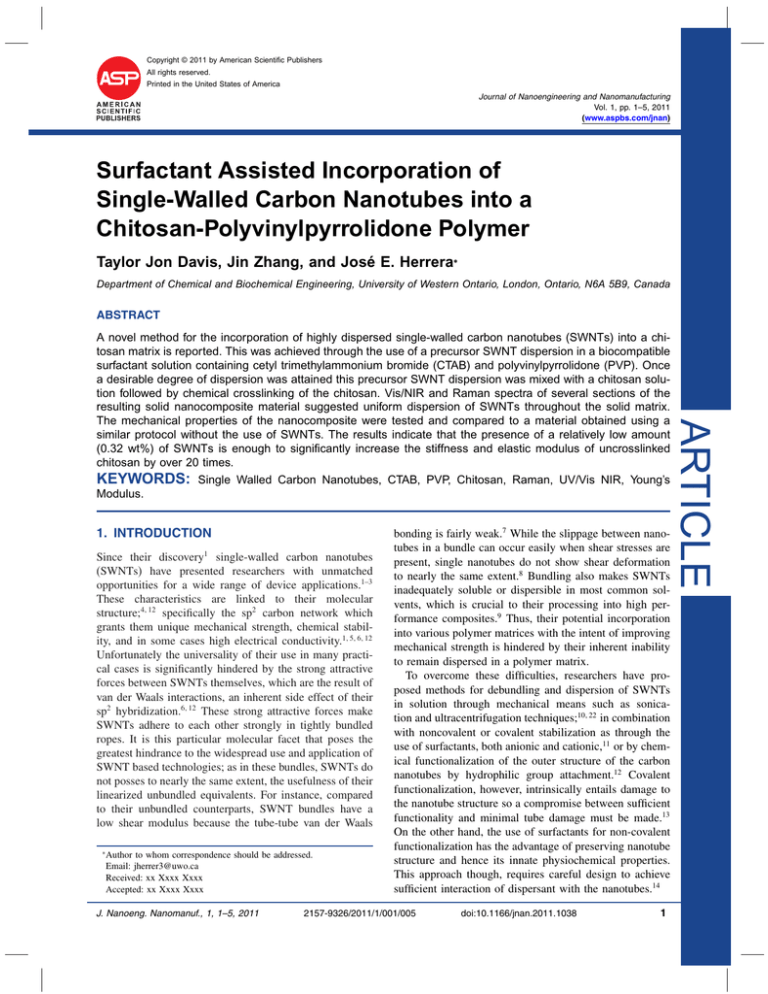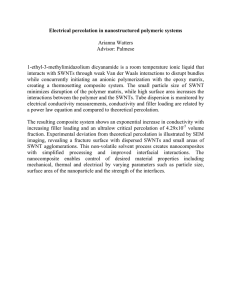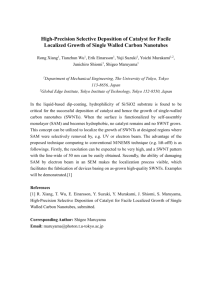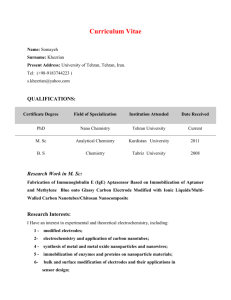
Copyright © 2011 by American Scientific Publishers
All rights reserved.
Printed in the United States of America
Journal of Nanoengineering and Nanomanufacturing
Vol. 1, pp. 1–5, 2011
(www.aspbs.com/jnan)
Surfactant Assisted Incorporation of
Single-Walled Carbon Nanotubes into a
Chitosan-Polyvinylpyrrolidone Polymer
Taylor Jon Davis, Jin Zhang, and José E. Herrera∗
Department of Chemical and Biochemical Engineering, University of Western Ontario, London, Ontario, N6A 5B9, Canada
ABSTRACT
KEYWORDS:
Single Walled Carbon Nanotubes, CTAB, PVP, Chitosan, Raman, UV/Vis NIR, Young’s
Modulus.
1. INTRODUCTION
Since their discovery1 single-walled carbon nanotubes
(SWNTs) have presented researchers with unmatched
opportunities for a wide range of device applications.1–3
These characteristics are linked to their molecular
structure;4 12 specifically the sp2 carbon network which
grants them unique mechanical strength, chemical stability, and in some cases high electrical conductivity.1 5 6 12
Unfortunately the universality of their use in many practical cases is significantly hindered by the strong attractive
forces between SWNTs themselves, which are the result of
van der Waals interactions, an inherent side effect of their
sp2 hybridization.6 12 These strong attractive forces make
SWNTs adhere to each other strongly in tightly bundled
ropes. It is this particular molecular facet that poses the
greatest hindrance to the widespread use and application of
SWNT based technologies; as in these bundles, SWNTs do
not posses to nearly the same extent, the usefulness of their
linearized unbundled equivalents. For instance, compared
to their unbundled counterparts, SWNT bundles have a
low shear modulus because the tube-tube van der Waals
∗
Author to whom correspondence should be addressed.
Email: jherrer3@uwo.ca
Received: xx Xxxx Xxxx
Accepted: xx Xxxx Xxxx
J. Nanoeng. Nanomanuf., 1, 1–5, 2011
bonding is fairly weak.7 While the slippage between nanotubes in a bundle can occur easily when shear stresses are
present, single nanotubes do not show shear deformation
to nearly the same extent.8 Bundling also makes SWNTs
inadequately soluble or dispersible in most common solvents, which is crucial to their processing into high performance composites.9 Thus, their potential incorporation
into various polymer matrices with the intent of improving
mechanical strength is hindered by their inherent inability
to remain dispersed in a polymer matrix.
To overcome these difficulties, researchers have proposed methods for debundling and dispersion of SWNTs
in solution through mechanical means such as sonication and ultracentrifugation techniques;10 22 in combination
with noncovalent or covalent stabilization as through the
use of surfactants, both anionic and cationic,11 or by chemical functionalization of the outer structure of the carbon
nanotubes by hydrophilic group attachment.12 Covalent
functionalization, however, intrinsically entails damage to
the nanotube structure so a compromise between sufficient
functionality and minimal tube damage must be made.13
On the other hand, the use of surfactants for non-covalent
functionalization has the advantage of preserving nanotube
structure and hence its innate physiochemical properties.
This approach though, requires careful design to achieve
sufficient interaction of dispersant with the nanotubes.14
2157-9326/2011/1/001/005
doi:10.1166/jnan.2011.1038
1
ARTICLE
A novel method for the incorporation of highly dispersed single-walled carbon nanotubes (SWNTs) into a chitosan matrix is reported. This was achieved through the use of a precursor SWNT dispersion in a biocompatible
surfactant solution containing cetyl trimethylammonium bromide (CTAB) and polyvinylpyrrolidone (PVP). Once
a desirable degree of dispersion was attained this precursor SWNT dispersion was mixed with a chitosan solution followed by chemical crosslinking of the chitosan. Vis/NIR and Raman spectra of several sections of the
resulting solid nanocomposite material suggested uniform dispersion of SWNTs throughout the solid matrix.
The mechanical properties of the nanocomposite were tested and compared to a material obtained using a
similar protocol without the use of SWNTs. The results indicate that the presence of a relatively low amount
(0.32 wt%) of SWNTs is enough to significantly increase the stiffness and elastic modulus of uncrosslinked
chitosan by over 20 times.
ARTICLE
Surfactant Assisted Incorporation of Single-Walled Carbon Nanotubes into a Chitosan-PVP Polymer
Besides surfactants, certain polymers are also capable of debundling and dispersing SWNT agglomerates.13
This is principally useful in instances where a polymer matrix is much more useful than a simple liquid
suspension of carbon nanotubes in solution, such as in
the synthesis of polymer-SWNT nanocomposites. In fact
SWNT-nanocomposite materials synthesis has received
considerable attention and research in the past five years,
driven by the unique properties of carbon nanotubes and
the potential to create new systems with superior properties
such as high tensile strength or electrical conductivity.15
Optimization of a polymer’s properties by SWNT incorporation however, is not so much dependent on the quantity of the incorporated nanotubes, but rather the quality
of their dispersion in the polymer matrix.16 For instance,
a greater dispersion results in a more linearized conformation of the nanotubes in the nanocomposite, which
in turn, results in a greater portion of an applied stress
being equally distributed across the length of the nanotubes. A good dispersion hence, takes full advantage of the
strength increase provided by the unique molecular framework of the nanotube itself. Consequently, because each
individual nanotube is so inherently strong, few are actually needed to provide a dramatic strength increase in a
nanocomposite to which they are incorporated, provided
they are extremely well dispersed. In contrast, adding an
excess of nanotubes to a polymeric material can result
in a nanocomposite with decreased mechanical strength
as there is a significant difficulty associated with creating
good dispersion in the precursor solution at high nanotube concentrations and also a higher chance of significant
reagglomeration post dispersion/incorporation.8
Among possible polymer/SWNT nanocomposite formulations, the use of chitosan matrixes is of particular
interest. As a biocompatible polymer, chitosan has been
thoroughly researched for medical, and industrial coating
applications.17 These applications tend to take advantage
of chitosan’s biocompatibility, high affinity for water, its
good mechanical strength, and the possibility of making
continuous, microscopic structures with improved mechanical properties, while retaining the capacity to absorb
liquids. Past work has shown that chitosan nanocomposite fibres with carbon nanotubes embedded in the polymer matrix offer a great deal of versatility for different
applications due to the availability of the hydroxyl and
amino groups present in chitosan.8 Though these functional groups offer the possibility of chemical functionalization to help increasing chitosan‘s chemical stability and
its resistance to biochemical and microbiological degradation, this polymer has an inherent poor heat tolerance and poor wet strength performance.18 19 Chitosan
blending with polymers such as polyvinyl alcohol or
polyvinylpyrrolidone (PVP) has been proposed as a way
to overcome these disadvantages such as to improve the
polymer’s rigidity.20 21
2
Davis et al.
In this contribution, we report preliminary results
we have obtained when trying to improve chitosan’s
mechanical strength by SWNT incorporation through a
carefully controlled dispersion into the polymer matrix.
Our approach includes the use of cetyl trimethylammonium bromide (CTAB), as a surfactant to debundle SWNTs
before incorporation into the polymer and the use of PVP
to integrate the nanotubes into the chitosan matrix.
2. EXPERIMENTAL DETAILS
2.1. Materials
Chitosan with medium molecular weight, (75–85%
deacetylated) was obtained from Sigma-Aldrich, US, and
used without further purification. The single-walled carbon nanotubes (SWNTs) were purchased from Cheaptubes.com (>90 wt% purity). The specifications provided
by the manufacturer indicated that the nanotubes had
lengths between 5–30 m, outer diameters between
1–2 nm and inner diameters between 0.8–1.6 nm.
All aqueous solutions and dispersions were prepared
using deionized water. Cetyl trimethylammonium bromide
(CTAB) (>99% purity) bought from Sigma Life Science,
was used as a surfactant. Additionally the polyvinylpyrrolidone (PVP) was bought from Sigma Life Science, with
average molecular weight 360000 g/mol. Gluteraldehyde
(grade 1, 25%) was bought from Sigma-Aldrich.
2.2. Methodology
SWNTs were first dispersed in a 25–30 mL surfactant
solution of 0.1 wt% CTAB, and 1 wt% PVP at a concentration of 0.2 g SWNT/L. This concentration was selected
based on past research which indicates it to be the optimum for SWNT dispersion using CTAB.22 The solution
was homogenized using a Branson Sonifier 250 (60 Hz,
200 W), at 90 W, for a period of two hours, which is
reported as the optimum sonication time.22 Immediately
following sonication the sample was ultracentrifuged using
a Sorvall WX Ultra 80, RC5B Super-speed Centrifuge
for a period of two hours at 40,000 rpm.22 Once centrifuged, the upper 50% of the resulting supernatant was
taken and filtered. The final solution was then analysed
using a Shimadzu 3600 UV/Vis/NIR spectrophotometer
to determine the extent of debundling, following a protocol previously reported (Ref. [22]). Incorporation of the
dispersed nanotube/surfactant solution into the chitosan
matrix was achieved by adding 10 mL of the dispersed
nanotube/CTAB/PVP solution to a 10 mL solution containing 2 wt% aqueous chitosan which had been prepared previously by dissolving solid powdered chitosan in 1–5 wt%
hydrochloric acid. The mixture was then mechanically
stirred for 24 hrs to ensure sufficient mixing. Subsequently
200 L of gluteraldehyde was added to the mixture in
order to crosslink the chitosan.23 A blank sample with
J. Nanoeng. Nanomanuf., 1, 1–5, 2011
3. RESULTS AND DISCUSSION
3.1. Spectroscopic Characterization of the
Nanocomposite
Figure 1 shows typical Raman spectra obtained on three
different sections of the SWNT-chitosan nanocomposite.
Even though the loading of SWNTs in the sample is relatively low (0.32 wt%), the spectra clearly shows typical
resonant SWNT signals arising from the radial breathing
mode (RBM) at 150–320 cm−1 , the G-band at 1500–
1600 cm−1 , and the very weak disorder peak (the D-band)
at 1300–1400 cm−1 , which is attributed to scattering from
sp3 carbon defects in the side walls of the SWNTs.
Figure 2 shows the detailed Raman spectrum in the RBM
region obtained for the nanocomposite together with the
spectra obtained for pristine samples of chitosan, PVP and
CTAB. This result clearly indicates that the peaks arising
180–300 cm−1 region are due to the presence of SWNTs
in the sample. Closer inspection of Figure 1 shows that the
D band in the nanocomposite is extremely weak. The D/G
band intensity ratio has been extensively used as an indication of the presence of sp3 carbon arising from covalent
functionalization.24 25 Comparison of the values obtained
J. Nanoeng. Nanomanuf., 1, 1–5, 2011
120
620
1120
1620
Wavenumber (cm–1)
Fig. 1. Raman spectra obtained on several sections of the SWNTchitosan nanocomposite material.
for the D/G intensity ratio observed on the nanocomposite are similar to those obtained on the pristine SWNT
material (not shown), suggesting that covalent functionalization has not taken place and the SWNT nanotubes
in the sample are not covalently attached to the polymer
matrix. This is an extremely important result, as it indicates that the sp2 structure of the SWNTs in the nanocomposite remains intact and hence mechanical properties that
are particularly dependent on the integrity of the sp2 network on the SWNTs is not compromised.
Figure 3 shows the NIR/Vis spectra obtained on the
SWNT-nanocomposite sample and the chitosan blank.
In the NIR region up to 700 nm the spectra is dominated
by the absorption features of the chitosan matrix. However in the visible region (400–700 nm) distinctive features are observed in the SWNT-chitosan sample. These
absorption peaks are not present on the optical absorption spectrum of the chitosan sample. The peaks observed
CTAB
PVP
SWNT-Composite
Chitosan
180
260
340
420
500
wavenumber (cm–1)
Fig. 2. Detailed Raman spectrum in the RBM region compared to spectra obtained for pristine chitosan, PVP, and CTAB samples.
3
ARTICLE
no SWNTs was prepared in the same way, i.e., by mixing 10 mL of a blank deionized water solution with a
10 mL, 2 wt% chitosan solution followed by crosslinking using 200 L of gluteraldehyde. The resultant samples were then dried using a Labconco, Freezone Plus
6 freeze dry system for 24 hrs to obtain the final solid
material.
Raman spectra on the resulting nanocomposite were
recorded using a Renishaw Model 2000 Raman spectrometer equipped with a 633 nm laser. Samples in solid form
were analyzed in macro mode using a 20X long working
length objective and 1.65 mW laser intensity. Vis/Near-IR
spectra of the chitosan nanocomposite with and without
SWNT were obtained using a Shimadzu 3600 UV/Vis/NIR
spectrophotometer in transmission mode. For this purpose
a thin section of each sample (1 mm thick, 6 mm diameter)
was hydrated and supported on a UV/Vis/NIR transparent
quartz slide for analysis.
Mechanical strength and durability were evaluated using
a BioTester 5000 test system (Cellscale Biomaterials Inc.)
by using a 2-rake mounting system. Specimens (chitosan composite with and without SWNTs), with a crosssectional area of 49×10−5 m2 , were analyzed. These were
stretched, respectively, with a loading of 0.2 mN applied
consistently across the surface of the sample. The loading increased at slow rate, 0.02 mN/s, and was applied
continuously at intervals lasting 5 seconds before being
allowed to recover. Meanwhile, the images of the deformation of the specimens were captured using a 1280 × 960
pixel charge coupled device CCD-camera.
Intensity (a.u.)
Surfactant Assisted Incorporation of Single-Walled Carbon Nanotubes into a Chitosan-PVP Polymer
Intensity (a.u.)
Davis et al.
Surfactant Assisted Incorporation of Single-Walled Carbon Nanotubes into a Chitosan-PVP Polymer
Davis et al.
chitosan scaffolds have about 2–5 times higher elastic
modulus (7.4–19.9 kPa) compared to their uncrosslinked
counterparts (∼3.8 kPa).26 In our specific case, both
SWNT loaded chitosan nanocomposites and an SWNTfree chitosan blank were tested using a tensile test.
Directional dependence of the samples with regard to
mechanical testing was not explored in this contribution
but future work will likely pursue this avenue of study. The
stress–strain curves obtained of both samples are depicted
in Figures 4(a and b). These results clearly indicate that
the Young’s modulus obtained on the SWNT-free chitosan
composite, chemically crosslinked is 10.8 kPa, whereas it
is 77.1 kPa for the SWNT loaded nanocomposite, demonstrating that the presence of a well dispersed, relatively
low amount (0.32 wt%) of SWNTs, is enough to significantly increase the stiffness and elastic modulus of
uncrossslinked chitosan by over 20 times.
3.6x103
Stress (σ, Pa)
on the SWNT-chitosan sample contain a good deal of
structure from van Hove transitions which can be linked
to second band gap transitions in semiconducting nanotubes and/or first band transitions in metallic nanotubes.
The presence of these absorption features is in agreement
with the Raman results depicted above and also confirms
that the sp2 network in the SWNT structure is not affected
by the chitosan matrix, since covalent attachment, and concomitant disruption of the pi network on the nanotube
would lead to the disappearance of the van Hove peaks in
the SWNT-chitosan sample.
(a) 4.2x103
3.0x103
2.4x103
1.8x103
1.2x103
0
3.2. Mechanical Test of the Nanocomposite
The equation used to describe the stress–strain curves
obtained for the different samples and their Young’s modulus (E), is described in Eq. (1) below,
F /A
E= =
L/L0
40
60
80
100
(b) 7.0x103
6.5x103
(1)
where and represent stress and strain respectively. E is
the Young’s modulus in Pascal (Pa), F the force applied
in Newton (N), and A the original cross-sectional area
through which the force is applied in square meters (m2 ).
L and L0 represent the displacement and the original
length of the materials respectively, both in meters (m).
The Young’s modulus is a measure of the stiffness of
a material. Normally, brittle materials, such as noncrosslinked chitosan, have a low elastic modulus, and any
applied force is distributed along only single chains of the
polymer. On the other hand, chemically crosslinked chitosan scaffold has been shown to possess higher stiffness
and elastic modulus. In fact, reports indicate crosslinked
4
20
Strain (ε, 100%)
Stress (σ, Pa)
ARTICLE
Fig. 3. VIS/NIR spectra obtained for the SWNT-polymer composite
(top) and the composite without nanotubes (bottom). Inset: detail of the
spectra in the visible region.
6.0x103
5.5x103
5.0x103
4.5x103
4.0x103
0
2
4
6
8
10
Strain (ε, 100%)
Fig. 4. Stress stain curves of (a) chitosan nanocomposite and (b) composite without SWNTs.
J. Nanoeng. Nanomanuf., 1, 1–5, 2011
Davis et al.
Surfactant Assisted Incorporation of Single-Walled Carbon Nanotubes into a Chitosan-PVP Polymer
4. CONCLUSION
The present work focused on the successful dispersion
and subsequent incorporation of SWNTs into a chitosan
matrix. On the basis of the results of these experiments,
we can conclude that SWNTs were successfully dispersed
using a surfactant solution containing CTAB and PVP, and
that this dispersion remained effective even after the solution was incorporated into a chitosan matrix and solidified.
Additionally we have shown that a significant increase in
the mechanical strength of the chitosan polymer has been
achieved as a result of the SWNTs incorporation into the
nanocomposite.
Acknowledgments: The financial support from the
Natural Sciences and Engineering Research Council of
Canada, The University of Western Ontario and the
Canadian Foundation for Innovation is gratefully acknowledged. We also gratefully thank Professor A. Bassi at The
University of Western Ontario for granting us access to the
ultracentrifuge.
1. S. Iijima, Nature 354, 56 (1991).
2. P. M. Ajayan, L. S. Schadler, C. Giannaris, and A. Rubio, Adv.
Matter. 12, 750 (2000).
3. P. M. Ajayan, Chem. Rev. 99, 1787 (1999).
4. M. S. Dresselhaus, G. Dresselhaus, and A. Jorio, Annu. Rev. Mater.
Sci. 34, 247 (2004).
5. V. V. Ivanovskaya and A. L. Ivanovskii, Inorgan. Mater. 43, 349
(2007).
6. A. Thess, R. Lee, P. Nikolaev, H. Dai, P. Petit, J. Robert, C. Xu,
Y. H. Lee, S. G. Kim, D. T. Colbert, G. Scuseria, D. Tomanek, J. E.
Fischer, and R. E. Smalley, Science 273, 483 (1996).
J. Nanoeng. Nanomanuf., 1, 1–5, 2011
5
ARTICLE
References and Notes
7. A. Kis, G. Csányi, J. P. Salvetat, T. N. Lee, E. Couteau, A. J. Kulik,
W. Benoit, J. Brugger, and L. Forró, Nature Mater. 3, 153 (2004).
8. G. M. Spinks, S. R. Shin, G. G. Wallace, P. G. Whitten, S. I. Kim,
and S. J. Kim, Sens. Actuators B 115, 678 (2006).
9. J. Shin, T. Premkumar, and K. E. Geckeler, Chem. Eur. J. 14, 6044
(2008).
10. M. J. O’Connell, S. M. Bachilo, C. B. Huffman, V. C. Moore, M. S.
Strano, E. H. Haroz, K. L. Rialon, P. J. Boul, W. H. Noon, C. Kittrell,
J. Ma, R. H. Hauge, R. B. Weisman, and R. E. Smalley, Science
297, 593 (2002).
11. L. Vaisman, H. D. Wagner, and G. Marom, Adv. Colloid Interface
Sci. 128–130, 37 (2006).
12. D. Tasis, N. Tagmatarchis, A. Bianco, and M. Prato, Chem. Rev.
106, 1105 (2006).
13. L. Y. Yan, Y. F. Poon, M. B. Chan-Park, Y. Chen, and Q. Zhang,
J. Phys. Chem. C. 112, 7579 (2008).
14. R. A. Graff, J. P. Swanson, P. W. Barone, S. Baik, D. A. Heller, and
M. S. Strano, Adv. Mater. 17, 980 (2005).
15. T. Ramanathan, H. Liu, and L. C. Brinson, J. Polym. Sci. Part B:
Polym. Phys. 43, 2269 (2005).
16. C. Biswas, K. K. Kim, H. Geng, H. K. Park, S. C. Lim, S. J. Chae,
S. M. Kim, and Y. H. Lee, J. Phys. Chem. C. 113, 10044 (2009).
17. D. Enescu and C. E. Olteanu, Chem. Eng. Commun. 195, 1269
(2008).
18. E. Guibal, T. Vincent, and R. N. Mendoza, J. Appl. Polym. Sci.
75, 119 (2000).
19. W. S. W. Ngah and I. M. Isa, J. Appl. Polym. Sci. 67, 1067 (1998).
20. L. Zhao, L. Xu, H. Mitomo, and F. Yoshii, Carbohydr. Polym.
64, 473 (2006).
21. J. Yeh, C. Chen, K. S. Huang, Y. H. Nien, J. L. Chen, and P. Z.
Huang, J. Appl. Polym. Sci. 101, 885 (2006).
22. Y. Tan and D. E. Resasco, J. Phys. Chem. B 109, 14454 (2005).
23. G. M. Laborie, A. P. Mathew, and K. Oksman, Biomacromolecules
10, 1627 (2009).
24. S. Qin, D. Qin, W. T. Ford, D. E. Resasco, and J. E. Herrera, Macromolecules 37, 752 (2004).
25. S. Qin, D. Qin, W. T. Ford, D. E. Resasco, and J. E. Herrera, J. Am.
Chem. Soc. 126, 170 (2004).
26. N. E. Suyatma, A. Copinet, L. Tighzert, and V. Coma, J. Polym.
Environ. 12, 1 (2004).






